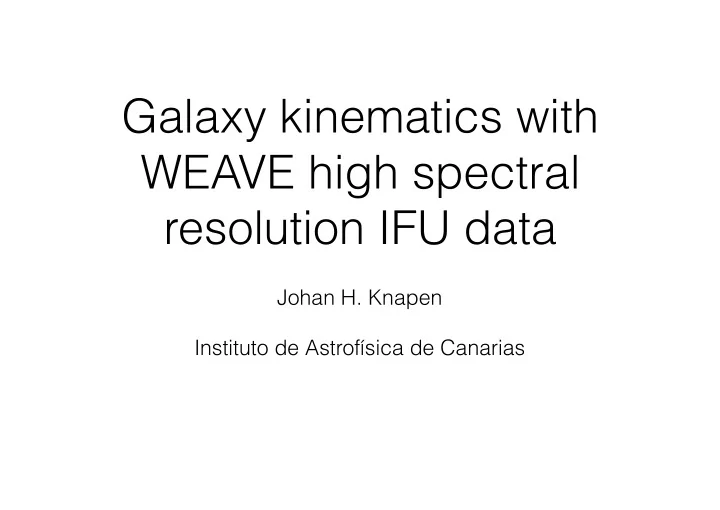

Galaxy kinematics with WEAVE high spectral resolution IFU data Johan H. Knapen Instituto de Astrofísica de Canarias
IFU galaxy kinematics • Widely available now from many surveys and instruments, incl. SAURON, MUSE, CALIFA, MaNGA, SAMI • Usually either limited spectral resolution, or field of view (or both…) • WEAVE IFU will give much higher spectral resolution data over field of view of 1.5 arcmin
Example 1: high-res data to look at gas streaming motions H α intensity (left) and velocity field (right) of NGC 1530. From Zurita et al. 2004, A&A, 413, 73 Data from TAURUS at WHT, 19 km/s/pixel
Model of circular motions (left) and residuals after subtracting this from velocity field (right)
• Velocity gradient map (left) shows regions of high shear, which coincide with location of dust lanes (right) • Clearly indicates shocks in bar-driven gas • From Zurita et al. 2004, A&A, 413, 73
Example 2: Inner rotation curve slopes • Fabry-Perot H α data with res. 8 km/s/pixel (FWHM 19.6 km/s) • GHaFaS instrument on WHT • Derive detailed inner rotation curves of few dozen galaxies • Could measure inner slopes of rotation curves, and compare with physical parameters of the galaxies • Erroz-Ferrer et al. 2016, MNRAS 458, 1119
• µ0 and T -type correlate with inner slope of rotation curve => T -type is related to the dynamics in the central parts of galaxies, quite plausibly through the radial mass distribution. • B/T and M bulge correlate with inner slope => bulges play a role in the dynamics of the central parts => baryonic mass dominates the dynamics in the inner regions • From Erroz-Ferrer et al. 2016, MNRAS 458, 1119 (see also Lelli et al. 2013)
WEAVE • Multi-object spectrograph for 4.2m William Herschel Telescope on La Palma • Operational early 2019 • 1000 fibres MOS + IFUs • 2 deg field • Low and high resolution modes • Robotic fibre positioner
WEAVE Characteristics Telescope, diameter WHT, 4.2m Field of view 2º ∅ Number of fibers 960 (plate A)/940 (plate B) Fiber size 1.3 ″ Number of small IFUs, size 20 x 11 ″ x12 ″ (1.3 ″ spaxels) LIFU size 1.3 ′ x1.5 ′ (2.6 ″ spaxels) Low-resolution mode resolution 5750 (3000–7500) (LIFU half of this) Low-resolution mode wavelength 3660–9590 coverage (Å) High-resolution mode resolution 21000 (13000–25000) (LIFU half of this) High-resolution mode wavelength 4040–4650, 4730–5450 coverage (Å) 5950–6850
!
Clockwise: WEAVE dummy top-end being lifted onto WHT; fibre positioner robots; part of spectrograph enclosure; holographic grating
Spectrograph Two arms split at 595 nm Switchable from low- to high-resolution
WEAVE-APERTIF survey strategy • Will observe 225 galaxies, each in HR (R=10000) and LR (R=2500) • Observing period 2019-2024 • Typical exposure time ~4h per galaxy (ranging from 30min to 10h, from the brightest objects to the fainter LSBs) • Wavelength ranges HR (4730-5450Å + 5959-6850Å), LR (3660-9840Å) • Main lines: • HR: Hß, Mgb, Fe5270, H α • LR: D4000, H δ , Hß, Mgb, Fe5270, H α , NaD, TiO2, CaT • PI is Jesús Falcón-Barroso (IAC)
Science goals • Why is there a bimodality in galaxy properties today, so that there are both star-forming blue galaxies and red, dead galaxies? • Where does the gas come from that fuels the star formation in these galaxies? • How is the star formation shut down? • How much dark matter do disc galaxies have, and how is it distributed? • How do processes like scattering of stars off spiral arms and bars, radial migration, or accretion of satellites manifest themselves in external disc galaxies? • Always combine information on gas flows (neutral and ionised) and stellar kinematics
Sample and data • Of order 225 nearby galaxies: need <1 kpc scale and few km/s spectral resolution • Neutral and ionised gas, and stellar tracers • APERTIF HI will give neutral gas velocity fields • WEAVE LIFU will give stellar and ionised gas kinematics and stellar populations
Participation • WEAVE is built by consortium of the partners in Isaac Newton Group of Telescopes (UK, NL, ES), plus participation from F, IT and various smaller parties • All researchers from UK, NL, ES are free to join, others may be able to join • Will operate with policies similar to SDSS, AS-4, in terms of participation, projects, publication • All reduced data available internally first, plus annual public data releases
Summary • IFUs are powerful instruments to derive gas and stellar kinematics in galaxies • Low spectral resolution and limited field of view are almost always limitations to science output • WEAVE will deliver high-resolution IFU data of over 200 nearby galaxies, starting 2018/19 • Welcome collaborations and use of the data (subject to participation rules)
Recommend
More recommend